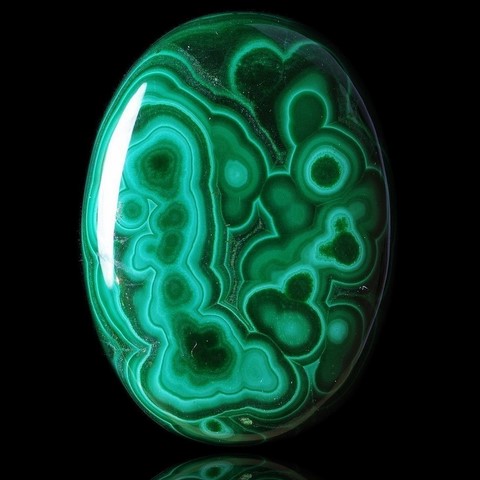MALACHITE
Class : Carbonates, nitrates, borates
Subclass : Anhydrous carbonates
Crystal system : Monoclinic
Chemistry : Cu2CO3(OH)2
Rarity : Very common
Malachite is a common secondary copper mineral. Its name comes from the ancient Greek "malakhê" (the mauve, a plant) because of its leaves green color that recalls the plant. It is generally presented in concretioned, stalactiform fibrous crystals with a concentric green color banding. Its surface is smooth to round, sometimes bristling. Visible crystals with unaided eyes are rare, small and elongated ; the large thick crystals are almost always azurite pseudomorphs. It is a mineral taht occurs in the oxidation area of copper deposits by alteration of primary copper minerals such as chalcopyrite. Malachite is a famous and beautiful ornamental stone, its polished sections have made it possible to dress furnitures and architectural elements. It is also widely used in jewelery. It can also be extracted as copper ore, particularly in Bisbee (USA), Tsumeb (Namibia) and Katanga (Democratic Republic of Congo). Crushed malachite is also a green pigment which has been used extensively in antiquity both as a makeup in ancient Egypt and as a pictorial art, but its color tends to fade under light.
Malachite in the World
Malachite in France
Malachite is easy to find in many locations in France, the most remarkable deposits are of course Chessy where malachite is associated with azurite. Amazing malachite pseudomorph after cuprite octahedra were extracted. It is also discovered in Cap Garonne (Var) in fibrous centimeter rosettes. Malachite pseudomorphs after tetrahedrite and bournonite occurs in Loiras quarry, at Camarès (Aveyron), Montroc, etc ...
Twinning and special forms
Malachite twins easily, however, due to the fibrous nature of the crystals, it is impossible to observe it without magnification.
There are many natural curiosities around malachite, starting with fossil replacements in Kerrouchen (Morocco). Many mineral transformations can be noted : the malachite pseudomorphs after cuprite from Chessy (France), malachite pseudomorphs after bournonites and tetrahedrites from Loiras (France), the African malachite pseudomorphs after azurite (Namibia, Morocco), the malachite pseudomorphs after baryte from Katanga...
Fakes and treatments

There are fake malachite stalactites on the market built on a plastered base and sprinkled with crushed malachite. It is possible to highlight this trick with an UV lamp (the glue fluoresce is generally yellow or orange), and if you look at these stalactites a little closer you will see the assembling.
In the world of gemstones and ornamental stones a resin immitating malachite has appeared on the market following the rarefactions of the material. It is often sold for malachite or under the name "malachite jasper". It is easily differentiated from natural stones, because it has much less shades of green and its parallel strips are much less regular (left picture).
It should also be noted that malachite can be reconstituted, small fragments of natural malachite can be linked together by a resin or a metal (usually copper) and then cut for a rather aesthetic patchwork rendering but not natural.
Hardness : 3 to 4
Density : 3,6 to 4,05
Fracture : Subconchoidal
Trace : Green
TP : Opaque to translucent
IR : 1,655 to 1,875
Birefringence : 0,254
Optical character : Biaxial -
Pleochroism : Medium
Fluorescence : None
Solubility : Nitric or hydrochloric acid
Magnetism : None
Radioactivity : None










